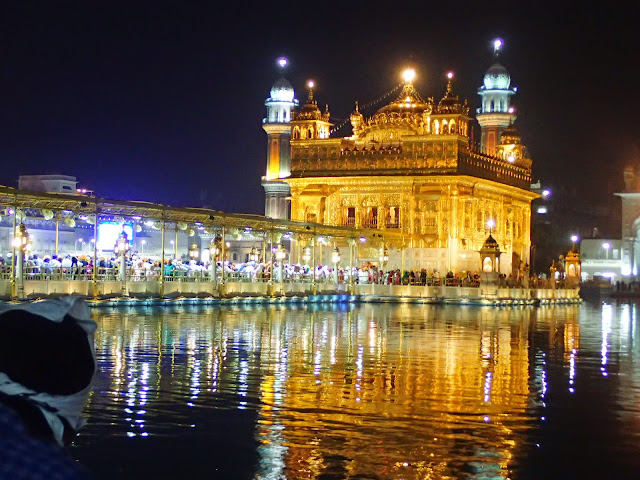Thursday and Friday, 24 -25 October 2014
Amritsar is a city of peace and unquiet at the same time. It is a city inhabited 70% by Sikhs, a friendly and accepting people. Sikhism is a newer religion, founded in the 15th century by Guru Nanak, rejecting caste and idolatry, and promoting the sameness of all human beings. Amritsar is home to the Golden Temple, the holiest Sikh gurdwara (place of worship); built in the 16th century, the Golden Temple houses the holy book, the Granth Sahib, which was designated as the 11th guru by the 10th (and last human) guru.
The Golden Temple is the peaceful part of Amritsar. On Thursday evening, Pati and BeeBee visited the Golden Temple and were even close enough to see the holy book put to sleep: the priests put the holy book in a golden palanquin and then carry it over their shoulders to a separate place for the night, to the sound of bugles, drums, and chanting the name of the Lord. (It is similarly carried back in the morning, which they did not see.) They were able to see the ceremony close up because their guide interceded with those in charge to make it possible explaining that Pati and BeeBee had traveled a long distance to see the ceremony and had a plane to catch in three hours. In fact, Pati and BeeBee did not have to catch a plane in the next three hours, but perhaps the guide was a little hazy about their itinerary, perhaps he forgot he would see them the next day ...
In the morning, they came back to experience the community kitchen (langar), which feeds over a thousand people continuously. This huge operation is staffed by volunteers. Each person fed can receive water, chapattis, dal (lentil soup), and a thin rice pudding. Pati and the guide (who is Hindu) had the full experience (without drinking the water) and BeeBee had chapattis only. They wrapped up the leftover chapattis in a tissue to feed to cows later (who are holy) because food should not be wasted. They walked clockwise around the temple grounds before they left.
The unpeaceful part of their visit was to the Jalianwala Bagh, about one city block from the Golden Temple. It is a martyr's memorial to an attack on 13 April 1919, at an important Sikh
festival, by British soldiers on thousands of unarmed Indians who could neither reason with the soldiers nor escape their bullets. 1650 rounds of ammunition were fired over 10 minutes. The Indian Nation Congress estimated 1500 casualities, with 1000 dead. Bullet holes are still clearly visible on walls preserved here. This memorial is effective and moving.
The memorial is a vivid reminder of the dark side of the relationship between England and its colonies.The guide, who is a cheerful 26-year-old, became quite serious when he described some of the sub-human treatment that the "Britishers" forced on the population. At this point, BeeBee understood his smile when she and Pati responded "US" to his question, upon their first meeting, of where they are from. (The Indians they have met have difficulty distinguishing among Americans, Australians, and British, based on the variety of English spoken.) As former colonists, Americans and Indians have similar views of certain events.
The memorial is a vivid reminder of the dark side of the relationship between England and its colonies.The guide, who is a cheerful 26-year-old, became quite serious when he described some of the sub-human treatment that the "Britishers" forced on the population. At this point, BeeBee understood his smile when she and Pati responded "US" to his question, upon their first meeting, of where they are from. (The Indians they have met have difficulty distinguishing among Americans, Australians, and British, based on the variety of English spoken.) As former colonists, Americans and Indians have similar views of certain events.
 |
| Golden Temple |
Golden Temple Langar



The memorial looks awesome! Glad you could get a pic.
ReplyDelete